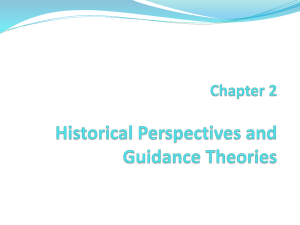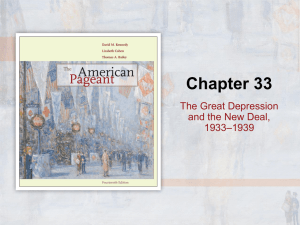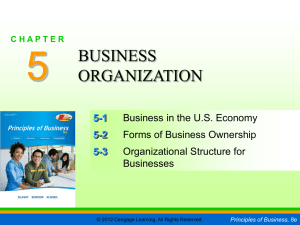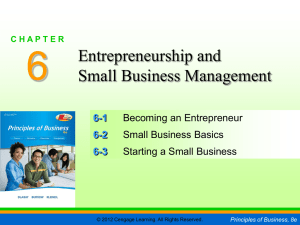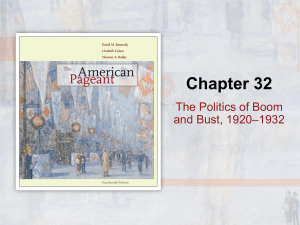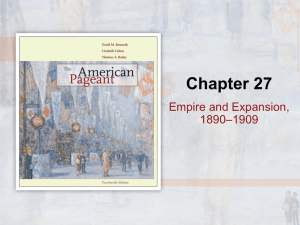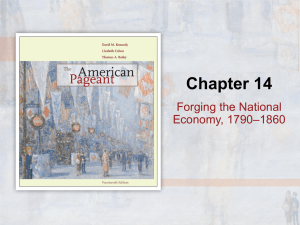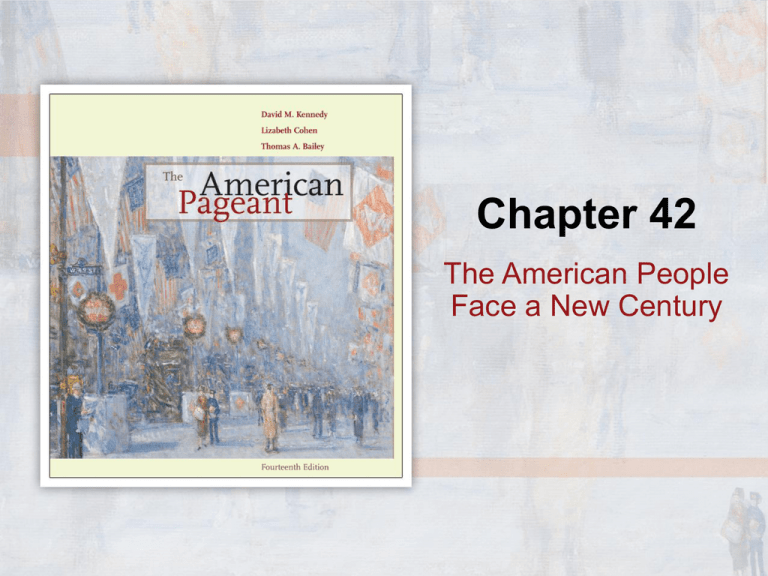
Chapter 42
The American People
Face a New Century
Question
The inventor(s) of the Internet included
a) Apple and Microsoft.
b) government and industry scientists.
c) Apple and International Business Machines.
d) Al Gore.
Copyright © Cengage Learning. All rights reserved.
42 | 2
Answer
The inventor(s) of the Internet included
a) Apple and Microsoft.
b) government and industry scientists. (correct)
c) Apple and International Business Machines.
d) Al Gore.
Hint: See page 1089.
Copyright © Cengage Learning. All rights reserved.
42 | 3
Question
All of the following were aspects of globalization EXCEPT
a) traditional geographic, social, and political boundaries could be
vaulted with the tap of a keypad.
b) white-collar jobs in financial services and high tech engineering
could now be “outsourced” to countries such as Ireland and
India.
c) the economic turbulence of the first years of the century
reminded Americans that their economy was scarcely immune
to the age-old vagaries of risk, error, scandal, and the business
cycle.
d) the widening income gap was primarily caused by the tax and
fiscal policies of the Reagan and both Bush (father and son)
presidencies, which favored the wealthy.
Copyright © Cengage Learning. All rights reserved.
42 | 4
Answer
All of the following were aspects of globalization EXCEPT
a) traditional geographic, social, and political boundaries could be
vaulted with the tap of a keypad.
b) white-collar jobs in financial services and high tech engineering
could now be “outsourced” to countries such as Ireland and
India.
c) the economic turbulence of the first years of the century
reminded Americans that their economy was scarcely immune
to the age-old vagaries of risk, error, scandal, and the business
cycle.
d) the widening income gap was primarily caused by the tax and
fiscal policies of the Reagan and both Bush (father and son)
presidencies, which favored the wealthy. (correct)
Hint: See page 1085.
Copyright © Cengage Learning. All rights reserved.
42 | 5
Question
All of the following are true of Big Science EXCEPT
a) the unusual demands of America’s national security state
during World War II and the Cold War required vast scientific
investments.
b) the result was Big Science, or multidisciplinary research
enterprises of unparalleled size, scope, and cost.
c) Big Science and Big Technology meant big bucks, big
machines, and big teams of scientists and engineers.
d) the close link between government and science was brand new
to the post-Cold War era.
Copyright © Cengage Learning. All rights reserved.
42 | 6
Answer
All of the following are true of Big Science EXCEPT
a) the unusual demands of America’s national security state
during World War II and the Cold War required vast scientific
investments.
b) the result was Big Science, or multidisciplinary research
enterprises of unparalleled size, scope, and cost.
c) Big Science and Big Technology meant big bucks, big
machines, and big teams of scientists and engineers.
d) the close link between government and science was brand new
to the post-Cold War era. (correct)
Hint: See page 1088.
Copyright © Cengage Learning. All rights reserved.
42 | 7
Question
All of the following were examples of American Big
Technology EXCEPT
a) Sputnik.
b) NASA.
c) SDI.
d) the Human Genome Project.
Copyright © Cengage Learning. All rights reserved.
42 | 8
Answer
All of the following were examples of American Big
Technology EXCEPT
a) Sputnik. (correct)
b) NASA.
c) SDI.
d) the Human Genome Project.
Hint: See pages 1088–1089.
Copyright © Cengage Learning. All rights reserved.
42 | 9
Question
All of the following American corporations
spearheaded a global revolution in
communications and information technology
EXCEPT
a) Apple.
b) International Business Machines (IBM).
c) Microsoft.
d) Rand-McNally.
Copyright © Cengage Learning. All rights reserved.
42 | 10
Answer
All of the following American corporations
spearheaded a global revolution in
communications and information technology
EXCEPT
a) Apple.
b) International Business Machines (IBM).
c) Microsoft.
d) Rand-McNally. (correct)
Hint: See pages 1088–1089.
Copyright © Cengage Learning. All rights reserved.
42 | 11
Question
All of the following contributed to the increase in
average life expectancy in the United States from
47.3 years in 1900 to 77.0 years in 2000 EXCEPT
physicians
a) discovered hormones and vitamins.
b) introduced penicillin and other antibiotics.
c) experimented with insulin therapy for diabetes and
radiation therapy for cancer.
d) discovered a cure for the AIDS epidemic.
Copyright © Cengage Learning. All rights reserved.
42 | 12
Answer
All of the following contributed to the increase in
average life expectancy in the United States from
47.3 years in 1900 to 77.0 years in 2000 EXCEPT
physicians
a) discovered hormones and vitamins.
b) introduced penicillin and other antibiotics.
c) experimented with insulin therapy for diabetes and
radiation therapy for cancer.
d) discovered a cure for the AIDS epidemic. (correct)
Hint: See page 1089.
Copyright © Cengage Learning. All rights reserved.
42 | 13
Question
Current evidence, which suggests that the United States
might be losing its preeminence in science includes all of
the following EXCEPT
a) American scientists are now winning fewer prizes and patents
and publishing fewer scientific papers than their peers in
Europe and Asia.
b) experts predict that current school-age Americans will not be
able to meet the rising demand for scientific expertise.
c) more foreigners will arrive to fill the gap, as international
competition for their labor slows up in places like Japan, China,
and India.
d) for the United States to retain preeminence in science in the
twenty-first century, it must continue to welcome all talent to the
field.
Copyright © Cengage Learning. All rights reserved.
42 | 14
Answer
Current evidence, which suggests that the United States
might be losing its preeminence in science includes all of
the following EXCEPT
a) American scientists are now winning fewer prizes and patents
and publishing fewer scientific papers than their peers in
Europe and Asia.
b) experts predict that current school-age Americans will not be
able to meet the rising demand for scientific expertise.
c) more foreigners will arrive to fill the gap, as international
competition for their labor slows up in places like Japan, China,
and India. (correct)
d) for the United States to retain preeminence in science in the
twenty-first century, it must continue to welcome all talent to the
field.
Hint: See page 1089.
Copyright © Cengage Learning. All rights reserved.
42 | 15
Question
All of the following were true of the “dot-com” explosion of
the late 1990s EXCEPT
a) new commercial ventures quickly expanded the market for
entrepreneurs.
b) new commercial ventures limited the stock-market stakes for
entrepreneurs.
c) it made the Internet a twenty-first-century electronic mall, town
square, library, and entertainment center rolled into one.
d) the very speed and efficiency of the new communications tools
threatened to wipe out entire occupational categories.
Copyright © Cengage Learning. All rights reserved.
42 | 16
Answer
All of the following were true of the “dot-com” explosion of
the late 1990s EXCEPT
a) new commercial ventures quickly expanded the market for
entrepreneurs.
b) new commercial ventures limited the stock-market stakes for
entrepreneurs. (correct)
c) it made the Internet a twenty-first-century electronic mall, town
square, library, and entertainment center rolled into one.
d) the very speed and efficiency of the new communications tools
threatened to wipe out entire occupational categories.
Hint: See pages 1084–1085.
Copyright © Cengage Learning. All rights reserved.
42 | 17
Question
The effects of scientific research and new scientific
knowledge included all of the following EXCEPT
a) new moral dilemmas.
b) new political arguments.
c) few strains of high-yield, pest-and weatherresistant crops.
d) the possibility of curing hereditary diseases.
Copyright © Cengage Learning. All rights reserved.
42 | 18
Answer
The effects of scientific research and new scientific
knowledge included all of the following EXCEPT
a) new moral dilemmas.
b) new political arguments.
c) few strains of high-yield, pest-and weatherresistant crops. (correct)
d) the possibility of curing hereditary diseases.
Hint: See page 1085.
Copyright © Cengage Learning. All rights reserved.
42 | 19
Question
All of the following were true of the American economy at
the beginning of the twenty-first century EXCEPT
a) Americans were still an affluent people.
b) median household income declined somewhat in the
early 1990s.
c) even Americans with incomes below the
government’s official poverty level enjoyed a
standard of living higher than that of two-thirds of the
rest of humankind.
d) Americans were still the world’s
wealthiest people.
Copyright © Cengage Learning. All rights reserved.
42 | 20
Answer
All of the following were true of the American economy at
the beginning of the twenty-first century EXCEPT
a) Americans were still an affluent people.
b) median household income declined somewhat in the
early 1990s.
c) even Americans with incomes below the
government’s official poverty level enjoyed a
standard of living higher than that of two-thirds of the
rest of humankind.
d) Americans were still the world’s
wealthiest people. (correct)
Hint: See page 1086.
Copyright © Cengage Learning. All rights reserved.
42 | 21

